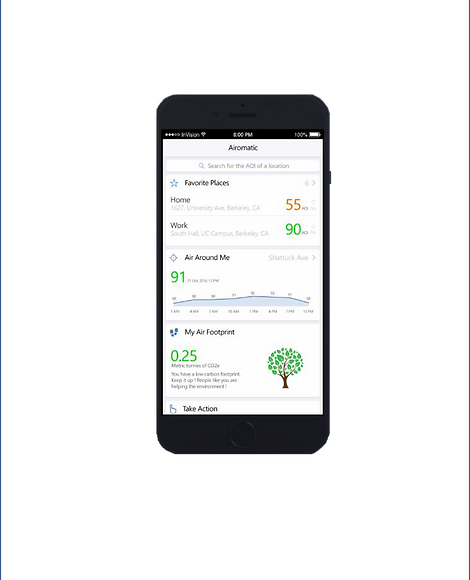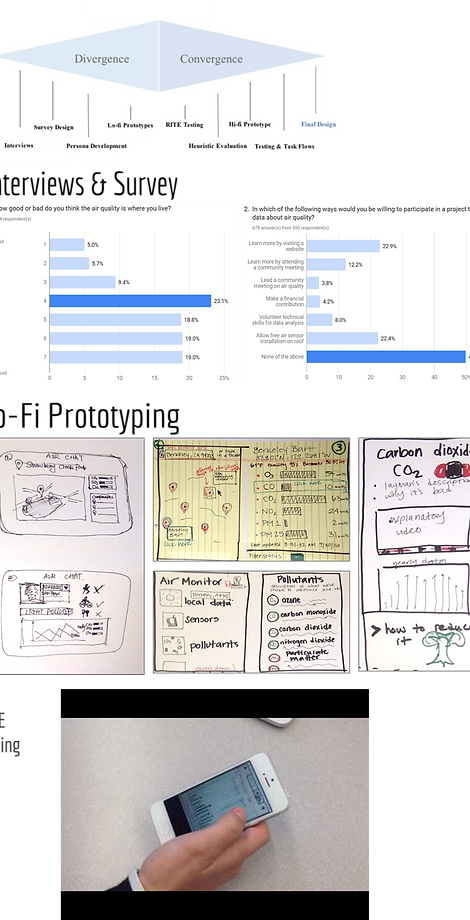
...
Addressing the design challenge: We believe our product offers a solution that blends personal awareness with communal accountability to meet all of those needs. We concentrate on concrete numerical values connected to explicit behaviors, with familiar interfaces (video, map, social media). By utilizing the map tool, users engage in reasoning about the air quality in their local community that can impact decision making at the household and municipal level. Tips and alerts that accompany data visualizations within the app can increase awareness of prolonged health concerns and broader environmental impacts.
Addressing user needs: The app design targets user needs by employing a methodical and informed process. The top layer of interactions presents information in a simple, accessible format and provides access to an introductory knowledge base when users become curious. Besides individual and community engagement, there is great value in the collective information output of the community, that can be utilized to generate ‘community dashboards’ and help city councils and municipalities to identify areas needing attention.

Outcome
The collective output of methods used in the design process resulted in a final version of Airomatic, an app with the following key features:
- Personalized information: Show air quality and alerts for users’ current and favorite locations
- Ease of interpretation: One simple color-coded number (AQI) that amalgamates many data
- Avenues for learning: Multi-modal descriptions of pollutants, sensors, and air pollution issues
- Allows active participation: Engage in discussions and events, share updates on social media
- Analytics and history: For users interested in details, a deeper level showing each pollutant being tracked as well as historical trends over time.

Design process
We began with a review of the literature around air quality and then dipped our toes in by starting some quick interviews and an online survey to assess what people's perceptions are about air quality and their willingness to contribute to the cause.
Based on survey results and some brainstorming, we developed three personas and defined key tasks they would want to perform on the app.
Then we moved to paper prototypes and tested several versions using Pop on smartphones.
Taking all the feedback and combining with heuristic evaluation of the designs, we converged on a final design. This analysis allowed us to make strategic decisions about how the home screen could best represent our most important design features, and incorporate descriptive text and simplified iconography that best demonstrated the functions and information of our application.
The Hi-Fi prototype was then developed in Adobe Photoshop and InVision. We utilized UserTesting.com for recording feedback of users recruited randomly across the US. Participants were provided with a summary of Airomatic’s purpose and sample tasks to complete. Audio and video recording of sessions allowed capturing feedback of these Think Aloud sessions. Critical errors identified were immediately corrected while suggestions requiring more time such as adding different timescales to pollutant levels, were noted for later iteration.

Team role
The most international team of five worked on this project. My specific contribution included 1) project management and coordination 2) interviews and survey design 3) persona development 4) lo-fi prototyping 5) user testing and 6) feedback on hi-fi prototyping

Users
Using survey results and brainstorming of team members, potential users of the app were segmented into three personas (tech savvy guy, young mom, high school student), to guide the development of app design. Understanding their expected goals and behaviors helped in synthesizing user needs.

Challenge
EPA solicited applications for deploying hundreds of air quality sensors and managing the data they collect (Smart City Air Challenge). This project focused on a part of this challenge: “Identifying best practices for managing big data at the community level, how to engage citizens in collecting data about their community, and how to use data from many sensors to understand environmental condition and its relationship to human health.”

AIROMATIC - MONITORING AIR QUALITY TOGETHER
Interface Design for EPA's air quality challenge to engage communities in monitoring air quality data and taking action to improve their environment.


